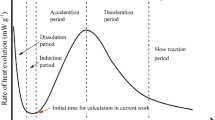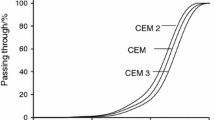Abstract
The hydration of cement is of great importance to the formation of the microstructure and development of strength. However, the complex nature of cement hydration results in that the existing manually derived model from some assumptions that are made to simplify the problem and make it mathematically and computationally tractable is not satisfactory in comparison with experimental results. In this paper, the middle-age hydration kinetics is distilled from observed data reversely using phased hybrid evolution method. The task that distils the hydration kinetics is divided into two phases and combines different algorithms. Furthermore, some strategies are also adopted for enhancement. To solve the problem of high time complexity, the searching process is accelerated by graphics processing units in parallel. The middle-age cement hydration kinetics model is distilled successfully from observed data. Studies show that the simulation result is close to the same with experimental results according to the distilled kinetics.















Similar content being viewed by others
Notes
These specimens were provided by The Cement Quality Supervision and Inspection Station of Shandong Province, China.
References
Anderson C (2008) The End of Theory: The Data Deluge Makes the Scientific Method Obsolete. http://www.wired.com/science/discoveries/magazine/16-07/pb_theory/
Avrami M (1939) Kinetics of phase change. J Chem Phys 7:1103–1112
Bae H, Jeon TR, Kim S, Han SS (2010) Modified genetic programming combining with particle swarm optimization and performance criterion in solar cell fabrication. Int J Control Autom Syst 8:841–849
Bentz DP (2011) Critical observations for the evaluation of cement hydration models. Int J Adv Eng Sci Appl Math 2:75–82
Bogue RH (1955) The chemistry of Portland cement. Reinhold Publishing Corporation, pp 245–268
Box GEP, Hunter JS, Hunter WG (2005) Statistics for experiments: design, innovation, and discovery, 2nd edn. Wiley, New York
Chen L (2005) Optimal design for machinery: genetic algorithm. Machinery Industry Press (in Chinese), Beijing
CUDA (2009) CUDA programming guide version 2.3.1, NVIDIA
Du X, Ding L, Jia L (2008) Asynchronous distributed parallel gene expression programming based on estimation of distribution algorithm. In: Proceedings 4th international conference national computing, pp 433–437
Dabic P, Krstulovic R, Rusic D (2000) A new approach in mathematical modelling of cement hydration development. Cem Concr Res 30:1017–1021
Fan WG, Gordon MD, Pathak P (2004) Discovery of context-specific ranking functions for effective information retrieval using genetic programming. IEEE Trans Knowl Data Eng 16:523–527
Ferreira C (2001) Gene expression programming: a new adaptive algorithm for solving problems. Comput Syst 13:87–129
Floares AG (2007) Automatic reverse engineering algorithm for drug gene regulating networks. In: Proceedings of 11th Iasted International Conference Artificial Intelligence Soft Computing, pp 238–243
Guan W, Szeto KY (2013) Topological effects on the performance of island model of parallel genetic algorithm. In: Proceedings international work conference artificial neural network, pp 11–19
Holland JH (1975) Adaptation in natural and artificial systems: an introductory analysis with applications to biology, control, and artificial intelligence, second edn. MIT Press, University of Michigan Press, p 1992
Huang Z, Lu X, Duan H (2012) A task operation model for resource allocation optimization in business process management. IEEE Trans Syst Man Cybern Part A Syst Hum 42:1256–1270
Iba H (2008) Inference of differential equation models by genetic programming. Inf Sci 178:4453–4468
Johnson WA, Mehl RF (1939) Reaction kinetics in processes of nucleation and growth. Trans Am Inst Min Metall Eng 135:416
Kennedy J, Eberhart RC (1995) A new optimizer using particle swarm theory. In: Proceedings of 6th international symposium micro machine human science, pp 39–43
Kondo R, Kodama M (1967) On the hydration kinetics of cement. Semento Gijutsu Nenpo 21:77–82 (in Japanese)
Koza JR (1992) Genetic programming: on the programming of computers by means of natural selection. MIT Press, Cambridge
Krogmann K, Kuperberg M, Reussner R (2010) Using genetic search for reverse engineering of parametric behavior models for performance prediction. IEEE Trans Softw Eng 36:865–877
Krstulovic R, Dabic P (2000) A conceptual model of the cement hydration process. Cem Concr Res 30:693–698
Lin F, Meyer C (2009) Hydration kinetics modeling of Portland cement considering the effects of curing temperature and applied pressure. Cem Concr Res 39:255–265
Luo GH, Huang SK, Chang YS, Yuan SM (2014) A parallel Bees Algorithm implementation on GPU. J Syst Archit 60:271–279
Oltean M, Dumitrescu D (2002) Multi expression programming. Technical report, UBB-01-2002, Babes-Bolyai University
Park KB, Noguchib T, Plawsky J (2005) Modeling of hydration reactions using neural networks to predict the average properties of cement paste. Cem Concr Res 35:1676–1684
Pignat C, Scrivener P, Navi K (2005) Simulation of cement paste microstructure hydration, pore space characterization and permeability determination. Mater Struct 38:459–466
Qian L, Wang H, Dougherty ER (2008) Inference of noisy nonlinear differential equation models for gene regulatory networks using genetic programming and Kalman filtering. IEEE Trans Signal Process 56:3327–3339
Robilliard D, Poty VM, Fonlupt C (2009) Genetic programming on graphics processing units. Genet Program Evol Mach 10:447–471
Sanz SS, Roldan FC, Heneghan C, Yao X (2007) Evolutionary design of digital filters with application to subband coding and data transmission. IEEE Trans Signal Process 55:1193–1203
Schindler AK, Folliard KJ (2005) Heat of hydration models for cementitious materials. ACI Mater J 102:24–33
Schmidt M, Lipson H (2009) Distilling free-form natural laws from experimental data. Science 324:81–85
Thomas JJ, Biernacki JJ, Bullard JW, Bishnoi S, Dolado JS, Scherer GW, Luttge A (2011) Modeling and simulation of cement hydration kinetics and microstructure development. Cem Concr Res 41:1257–1278
Tomosawa F (1997) Development of a kinetic model for hydration of cement. In: Proceedings of tenth international congress chemistry of cement, pp 2ii051
Vega FF, Gil GG, Pulido JAG, Guisado JL (2004) Control of bloat in genetic programming by means of the island model. In: Proceedings of international conference parallel prob solv nat, pp 263–271
Wang L, Yang B, Zhao XY, Chen YH, Chang J (2010) Reverse extraction of early-age hydration kinetic equation from observed data of Portland cement. Sci China Technol Sci 53:1540–1553
Wang L, Yang B, Chen YH, Zhao XY, Chang J, Wang HY (2012) Modeling early-age hydration kinetics of Portland cement using flexible neural tree. Neural Comput Appl 21:877–889
Wang L, Yang B, Chen YH, Zhao XY (2012) Predict the hydration of Portland cement using differential evolution. In: Proceedings of IEEE congress evolution computer, pp 3388–3392
Wang PM, Feng SX, Liu XP (2005) Research approaches of cement hydration degree and their development. J Build Mater 8:646–652 (in Chinese)
Yan LP, Zeng JC (2006) Using particle swarm optimization and genetic programming to evolve classification rules. In: Proceedings of 6th world congress intelligence control automation, pp 3415–3419
Yang ZY, Li XL, Bowers CP, Schnier T, Tang K, Yao X (2012) An efficient evolutionary approach to parameter identification in a building thermal model. IEEE Trans Syst Man Cybern Part C Appl Rev 42:957–969
Zhang S, He Z (2009) Implementation of parallel genetic algorithm based on CUDA. In: Proceedings of international symposium intelligence computer application, pp 24–30
Zheng L, Lu Y, Guo M, Guo S, Xu CZ (2014) Architecture-based design and optimization of genetic algorithms on multi- and many-core systems. Future Gener Comput Syst 38:75–91
Zhou Y, Tan Y (2009) GPU-based Parallel Particle Swarm Optimization. In: Proceedings of IEEE congress evolution computer, pp 1493–1500
Acknowledgments
This work was supported by National Natural Science Foundation of China under Grant No. 61203105, No. 61173078, No. 61373054, No. 61173079, No. 81301298, No.61302128. Shandong Provincial Natural Science Foundation, China, under Grant No. ZR2012FQ016, No. ZR2012FM010. National Key Technology Research and Development Program of the Ministry of Science and Technology under Grant 2012BAF12B07-3.
Author information
Authors and Affiliations
Corresponding author
Additional information
Communicated by V. Loia.
Rights and permissions
About this article
Cite this article
Wang, L., Yang, B. & Abraham, A. Distilling middle-age cement hydration kinetics from observed data using phased hybrid evolution. Soft Comput 20, 3637–3656 (2016). https://doi.org/10.1007/s00500-015-1723-4
Published:
Issue Date:
DOI: https://doi.org/10.1007/s00500-015-1723-4




